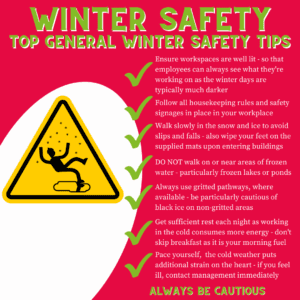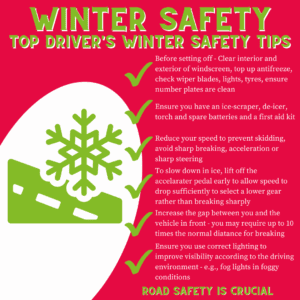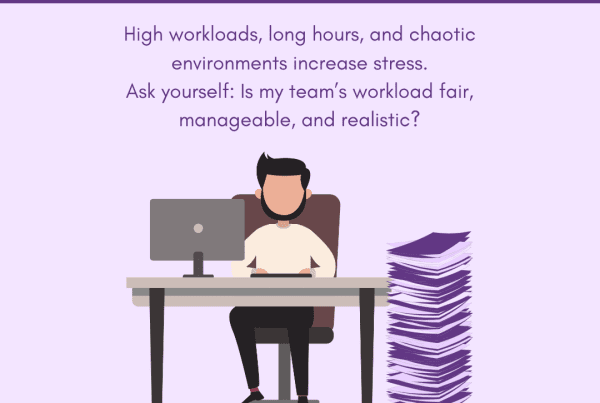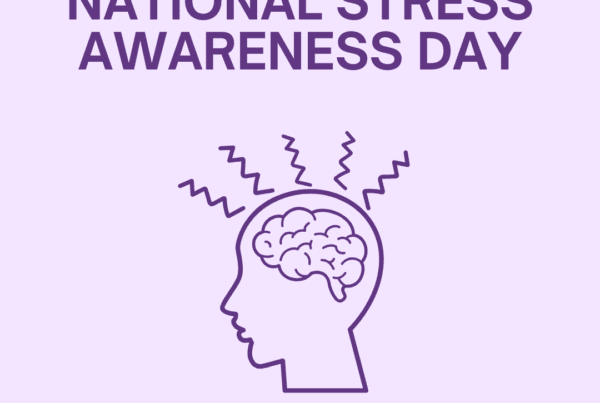With Winter approaching, it is important to be prepared for additional risks on top of your normal work and day-to-day activities.
To prevent the likelihood of common winter mishaps, such as – slips, trips and falls, driving incidents, frostbite, and hypothermia, from occurring, familiarize yourself with the following advice and adhere to the control measures in place.
1. Weather conditions
The weather conditions vary every day in winter months with the risk of ice, snow, and/or fog, and it is important that you:
- Stay focused on your path of travel.
- DO NOT take shortcuts through icy/snowy/foggy areas – stick to designated walkways/driving routes that have been sanded/salted or lit up.
- Be mindful of possible slips, trips and falls hazards and take necessary steps to avoid them.
- If you come across slippery surfaces, DO report to your manager to bring attention to the hazard, so your co-workers do not become injured – try signage or flagging off the area.
- ALWAYS be vigilant of other vehicles, pedestrians, and children in your travel path when driving as visibility may be restricted. E.g., if you are required to stop suddenly, the vehicle will not stop at the normal breaking distance and may slide and collide with other vehicles or persons resulting in severe damage or injury.
- ALWAYS wear hi-vis clothing where necessary.
2. Increased risk of slipping, tripping and falling
The risk of slips, trips and falls increase during the winter months due to the cold weather spells causing risk of ice, snow and/or fog. The most effective actions you should take to reduce the risk of slips, trips and falls include:
Lighting / Housekeeping:
- ALWAYS stay in well lit areas.
- ALWAYS use a torch if you are expected to enter areas of limited lighting.
- ALWAYS follow all housekeeping rules in place for the workplace/site.
- Follow all safety signages in place on the site.
- Report any faults in lighting or housekeeping to your manager immediately.
Footwear:
- ALWAYS ensure the soles of your footwear have adequate tread to prevent slips and falls on wet or icy surfaces.
- ALWAYS tie or strappen your boots tightly to give you the correct support and prevent a potential tripping hazard.
- Use the large absorbent mats in place when entering any buildings to ensure your footwear is dry.
Ice, frost and snow:
- ALWAYS walk slowly whilst looking out for slippy areas especially entering and exiting buildings and vehicles.
- ALWAYS use the gritted pathways where available.
- ALWAYS adhere to any temporary walkways or barrier off areas put in place.
- DO NOT take shortcuts over grass or unpaved areas as these may also become slippery and are less likely to be maintained.
- DO NOT attempt to pour hot water onto icy surfaces as an attempt to thraw out the area quicker – this will increase the risk of slips, trips and falls.
- ALWAYS be cautious of black ice in external ground especially pathways and carpark areas.

3. Driving safely in the snow and ice and fog
Before setting off:
- Follow all housekeeping rules in place within your vehicle.
- Keep the windscreen and other windows clear of dirt, ice and snow to avoid a fine.
- Clear snow from the roof – it can fall onto the windscreen and block your view.
- Air-con demists the screen faster and reduces condensation.
- Top up antifreeze.
- Replace worn or damage wiper blades.
- Check all lights are working and lenses are clean.
- Check tyre pressures and tyre tred depths before driving.
- Keep number plates clean.
- Keep lights on at all times – if using fog lights remember to switch them off when visibility improves so they do not impair other drivers vision or obsecure your break lights.
- Ensure you have an ice-scraper, de-icer, torch and spare batteries and first aid kit.
- ALWAYS drive with suitable footwear. If your footwear is not sufficient you should change into suitable driving footwear to reduce the risk of slipping off the pedals.
- Listen to local weather broadcasts and travel bulletins as conditions may change rapidly.
When driving in ice/snow:
- Reduce your speed as the chances of skidding are much greater and your stopping distance will increase massively.
- Adhere to all road safety signages and speed limits in place especially any temporary ones.
- Avoid harsh braking and acceleration or sharp steering.
- ALWAYS reduce your speed smoothly and slow down in plenty of time before bends and corners.
- Breaking on an icy or snow covered bend is extremely dangerous. The centrifugal force will continue to pull you outwards and the wheels will not grip very well. This could cause your vehicle to spin.
- To slow down on ice and snow, lift off the accelerater pedal early to allow the speed to drop sufficiently to select a lower gear. If you need to use the brakes, use them with very gentle force depressing on the clutch early to avoid stalling of the engine.
- Increase the gap between you and the vehicle in front. You may need up to 10 TIMES the normal distance for breaking.
- In snowy conditions, stop frequently (if safe to do so) and clean the windows, wheel arches, lights and number plate.
- Visibility will probably be reduced so use the dipped headlights at all times.
- Keep vehicle well-ventilated as too much heat when driving can cause drowsiness.
- ALWAYS be aware of other drivers and pedestrians – especially children!
When driving on flooded roads / Aquaplaning:
- Reduce speed when on the roads as rain water can increase the risk of black ice or risk of slidding causing collision.
- Use windscreen wipers, washers and dipped headlights, drive smoothly and plan your manoeuvres in plenty of time.
- REMEMBER you will need a minimum of TWICE your normal breaking distance in these conditions.
- AVOID the deepest water – which is usually near the kerb.
- DO NOT attempt to cross if the water seems too deep.
- If you are not sure of the water’s depth, look for an alternative route.
- If you decide to risk it, drive slowly in first gear but keep the engine speed high by slipping the clutch – this will stop you from stalling.
- BE AWARE of the bow wave from approaching vehicles – operate an informal ‘give way’ with approaching vehicles.
- REMEMBER to test your brakes after you have driven through a flooded area.
- If aquaplaning occurs, ease off the accelerator and brakes until your speed drops sufficiently for the vehicle tyres to make contact with the road again.
When driving in fog:
- Follow weather forecasts and general advice to drivers in the local and national media.
- ALWAYS allow plenty of extra time for your journey.
- Check your car before you set off. Make sure everything is in good working order, especially the lights.
- Reduce your speed and keep it down.
- Switch on headlights and fog lamps if visibility is reduced.
- If you can see the vehicles to your rear, the drivers behind can see you – switch off your rear fog lamps to avoid dazzling them.
- Use the demister and windscreen wipers.
- DO NOT ‘hang on’ to the rear lights of the car in front as you will be too close to be able to brake safely.
- Switch off distracting noises and open the window slightly so that you can listen for other traffic, especially at crossroads, slip ways and junctions.
- BE AWARE of speeding up immediately when visibility improves slightly. In patchy fog you could find yourself ‘driving blind’ again only moments later.
- If you break down, inform the police and get the vehicle off the road as soon as possible. Never park on the road in fog and never leave it without warning lights of some kind if it is on the wrong side of the road. Inform your manager immediately of your break down.
When driving in low sunshine:
- Reduce your speed.
- Reduce the effect of glare by keeping both the inside and outside of your windscreen clean and grease free.
- If you wear sunglasses (with prescription lenses if necessary) take them off whenever the sun goes down. They should not be worn in duller weather or at night as they seriously reduce the ability to see.


4. If you’re stuck in the ice/snow/fog/accident
- If you get stuck in the snow or ice or held up in an accident, report this immediately to your manager (when safe to do so!).
- If you get stuck in snow, revving your engine to try to power out of the rut will just make the rut worse.
- Instead, move your vehicle slowly backwards and forwards out of the rut using the highest gear you can.
- DO NOT leave your vehicle if you are not able to free yourself.
- Call your manager, breakdown service or the emergency service and let them come to help you.
- DO NOT run the engine to keep warm – use your Winter Emergency Kit.
No matter how safely you drive, there is still a chance you could get stuck somewhere in poor weather. Pack a Winter Emergency Kit, including the following:
- Warm clothes, waterproofs and high-vis jackets
- Sturdy footwear
- Hot drinks and snacks – preferably non-perishable
- Snow shovel
- Jump leads
- Warning triangles.

Another key risk of unsafe working in the winter is frostbite and hypothermia.
Hypothermia is a potentially fatal condition caused by loss of body temperature e.g., exposed skin can start to freeze at just -2°C. Frostbite can cause blood clots and even gangrene.
Symptoms include fatigue, nausea, confusion, light-headedness, and profuse sweating. Without medical treatment, the victim can lose consciousness and die.
ALWAYS report to your manager immediately if you experience any of these symptoms.
5. Dress appropriately for cold weather
Wear layers – you are getting additional protection from the cold temperatures and can add or remove clothing as required. Wear a thin t-shirt as your first layer, then put a warmer jumper over the top of it, followed by a well-insulated coat. Doing so will give you multiple layers of protection from the cold weather. DO NOT wear too many layers of clothing that may restrict your ability to move freely, this would be a hazard in itself!
Wear a hat – as much as half your body heat can escape from the top of your head. Wearing a hat can also protect your ears from frostbite.
Wear gloves – these should have enough insulation to keep you warm and prevent frostbite, but be thin enough so that you can feel what you are doing if you are manipulating controls or tools. Gloves that are too thick can prevent you safely conducting your job and cause possible repetitive strain injury.
Footwear – ensure the soles of your footwear have adequate tread to prevent slips and falls on wet or icy surfaces.
- ALWAYS check your winter wardrobe for entanglement hazards such as scarves, loose sleeves, and dangling drawstrings. Basically, anything that could get caught in tools/equipment or machinery.
- ALWAYS ensure your clothing choices align with your employers Personal Protective Equipment (PPE) policies.
 6. Welfare
6. Welfare
- Get plenty of rest as working in the cold, even when travelling to and from work in the winter months, takes more energy.
- Make sure you eat well and have regular hot food.
- DO NOT skip on breakfast as this will provide you with the fuel to start your day.
- Pace yourself – the colder weather puts extra strain on your heart!
- If you feel ill at any time, contact your manager immediately.




